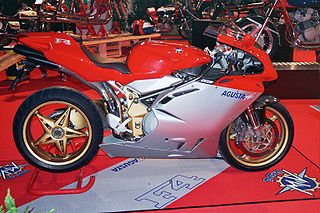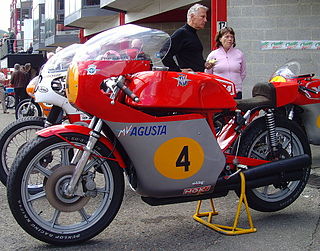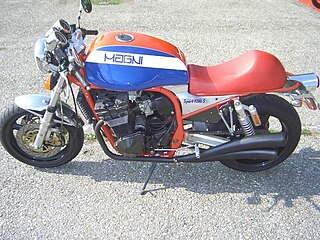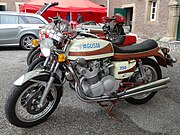
MV Agusta is a high end motorcycle manufacturer founded by Count Domenico Agusta on 19 January 1945 as one of the branches of the Agusta aircraft company near Milan in Cascina Costa, Italy. The abbreviation MV stands for Meccanica (mechanics) Verghera, the hamlet where the first MVs were made. The modern headquarters and main production facilities are located in Varese, Italy on the shore of Lake Varese.

The MV Agusta F4 is an inline four-cylinder sport bike made by MV Agusta from 1999 until 2018. It was the motorcycle that launched the resurrection of the brand in 1998. The F4 was created by motorcycle designer Massimo Tamburini at CRC, following his work on the Ducati 916. The F4 has a single-sided swingarm, large diameter front forks and traditional MV Agusta red and silver livery. The F4 engine is also one of the few production superbikes to have a hemi-spherical cylinder head chamber design with 4 valves per cylinder.

The MV Agusta Brutale series of motorcycles are manufactured by MV Agusta of Italy, starting in 2001. Its style is classified as a naked bike and the series consists of several models powered by either inline-four or inline-three, DOHC-engines in various capacities.

The L-twin is a naturally aspirated two-cylinder petrol engine by Ducati. It uses a 90-degree layout and 270-degree firing order and is mounted with one cylinder horizontal.

The MV Agusta 500cc Three (1965–1973) or MV Agusta Tre was a road racing motorcycle produced by the Italian manufacturer MV Agusta to compete in the 500 cc Grand Prix motorcycle racing World Championship. The motorcycle was introduced in 1966 to compete against the ever competitive Honda racing machines and was a bored out version of MV Agusta's highly successful 350 cc three cylinder. Giacomo Agostini won consecutive world championships in the 500 cc class with this motorbike from 1966 to 1972. In addition, MV Agusta won the Constructors' World Championships from 1967 to 1972. The MV Agusta Tre is considered the most successful racing motorcycle in history.

The MV Agusta 350B (Bicilindrica) was a series of motorcycles produced by the Italian manufacturer MV Agusta from 1970 to 1974. The motorcycle was first introduced at the Milan motorcycle show in 1969. The introduction of the "350" model was intended to bridge the production gap of MV Agusta in the medium-displacement sector and to take advantage of the prestige gained by the dominant GP racers. It was produced in "Sport", "Gran Turismo" and "Scrambler" versions.

The MV Agusta 750 Sport America was a motorcycle manufactured by the MV Agusta company from 1975 to 1977. Derivative models were produced in limited numbers until 1982, and the Magni models are still available to special order.

The MV Agusta 600, also called the MV Agusta 600 4C and the MV Agusta 600 Turismo, was a motorcycle built by the MV Agusta company from 1966 to 1970. For the first time, a four-cylinder engine was fitted transversely to the direction of travel on a standard motorbike and cable-operated disc brakes were used. A total of 135 of this model were manufactured.

The MV Agusta 500 four-cylinder (1973–1976) was a racing motorcycle manufactured by the Italian company MV Agusta, for competing in the 500 cc series, the premier class of the FIM World Motorcycle Championship. With this motorcycle MV Agusta won the 1973 constructor's world champion and Phil Read won the 1973 and 1974 500 cc riders world championships.

The MV Agusta 350 6 cilindri was a prototype racing motorcycle built by the Varese company MV Agusta in 1957, for the 350 cc class of the FIM Motorcycle World Championship. The project was resurrected in 1968. Neither version was ever used in a race. The only surviving model is now in the MV Agusta factory museum.

The MV Agusta 175 were a series of motorcycles produced by the Italian manufacturer MV Agusta from 1953 to 1960. The series included touring, GT, sports and supersports models. There were also two racing variants. Because of the shape of the petrol tank, the sports and supersport models became known as the Disco Volante. The series was MV's best seller.

The MV Agusta 125 Bialbero was a 125 cc factory racer from the Italian brand MV Agusta, which was used between 1950 and 1960. The machine won 34 GPs, 6 rider's championships and one manufacturer's championship. The machine also won 4 Italian Championships and 10 National Championships in other countries.

The MV Agusta 350 Ipotesi (Hypothesis) was a motorcycle produced by the Italian manufacturer MV Agusta from 1975 to 1977. The machine was conceived by Italian designer Giorgetto Giugiaro and based on the previous 350 B Sport Elettronica model. 1,991 "Sports" and 350 “Turismo” machines were produced.

The MV Agusta 125 Regolarità was a dual-sport motorcycle built from 1965 to 1970 by the Italian manufacturer MV Agusta at their Cascina Costa plant. Production was 63 machines, built in 2 batches; 46 in 1965 and 17 in 1969.

The MV Agusta 125 Sport SE was a sport motorcycle built from 1975 to 1977 by the Italian manufacturer MV Agusta. It was one of the last models to be produced by Meccanica Verghera at their Cascina Costa plant.

The MV Agusta 150 Sport RS was a motorcycle produced by the Italian motorcycle MV Agusta in their Cascina Costa plant from 1959 to 1969.

Magni is an Italian company that builds specialist motorcycles. The company is based in the city of Samarate in the province of Varese. Magni, in addition to building the bikes that bear its name, is also active in the construction of specials to order and a supplier of special parts for the restoration of MV Agusta classic motorcycles.

Hansen & Schneider were a range of limited production motorcycles produced by the German MV Agusta importers Michael Hansen and engineer Roland Schneider based on the MV Agusta 750 Sport America and the 350 Ipotesi models. The machines were manufactured from 1975 to 1982.
The MV Agusta 250B (Bicilindrica) was a motorcycle produced by the Italian manufacturer MV Agusta from 1968 to 1971. The motorcycle was first introduced at the 1965 Milan EICMA motorcycle show and was based on the stillborn MV 166 Arno GT. The model was discontinued in 1971 following the introduction of an overbored version, the 350B.
The Ducati parallel twins are a series of 350 cc (21 cu in) and 500 cc (31 cu in) parallel twin SOHC motorcycles produced by the Italian manufacturer Ducati from 1975 to 1981, although 67 Sports Desmos were supplied to Australian importer Frazers in 1983. These were likely built from spares. The 500cc versions were also produced under licence in Spain by MotoTrans, where production continued until 1983. Sales were poor and the machines were unreliable, earning them the nickname of paralysed twins.




















